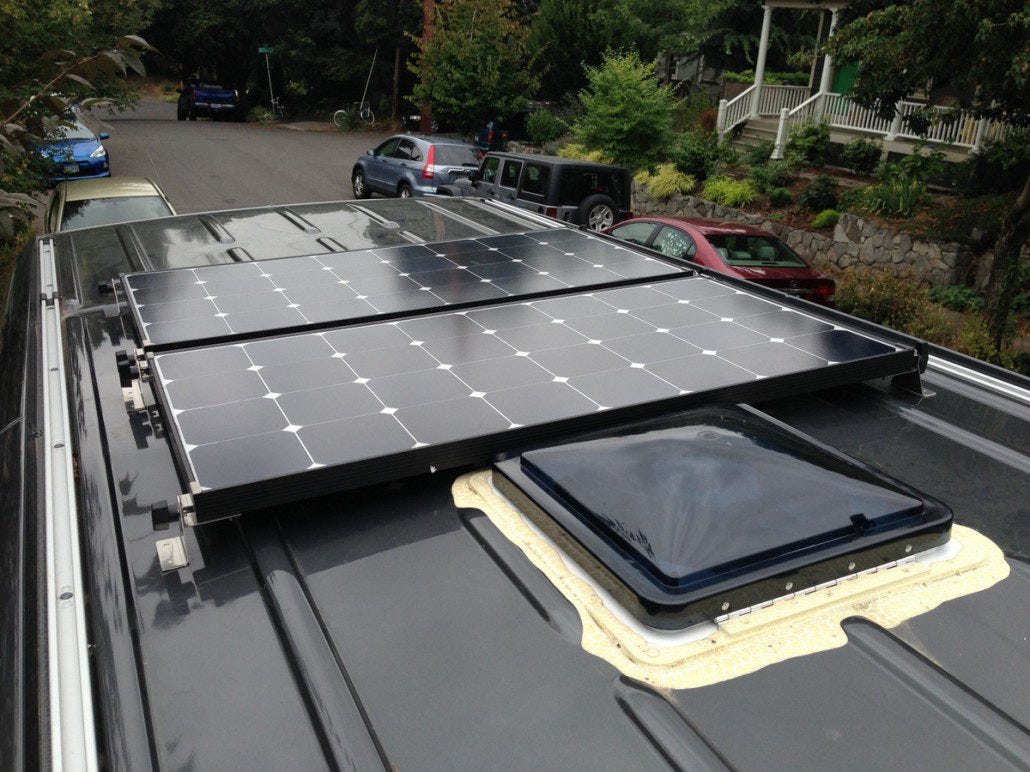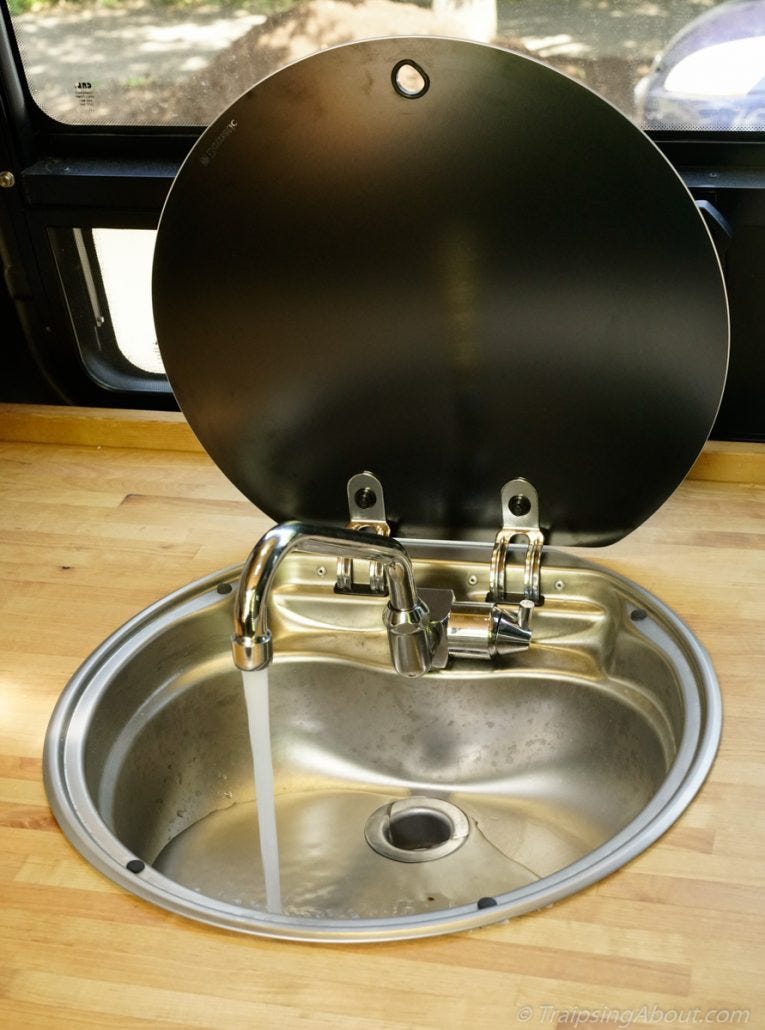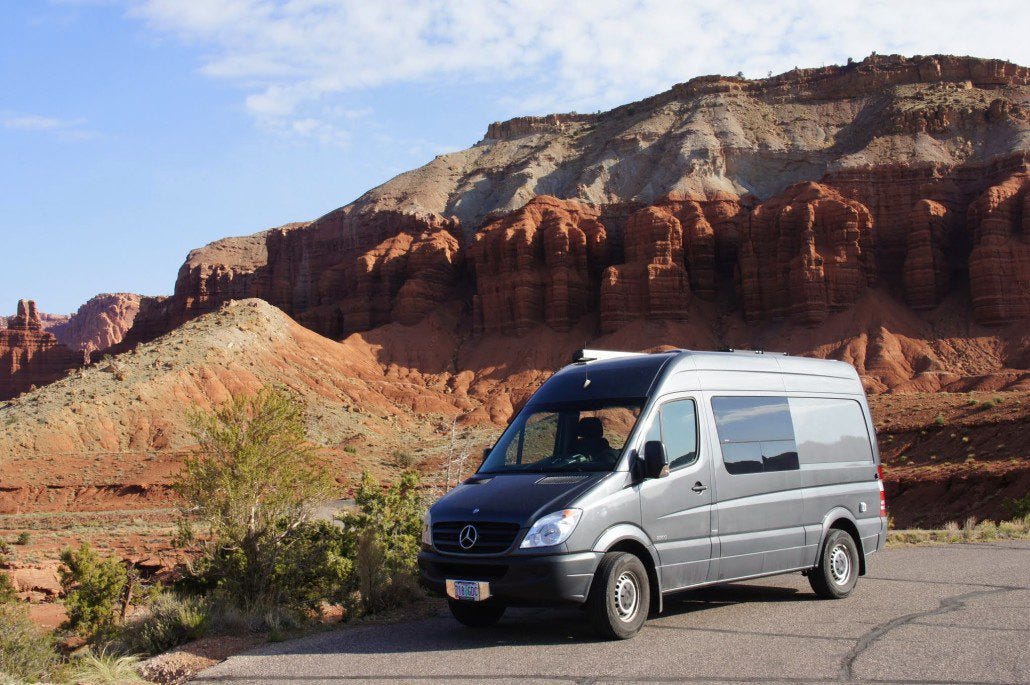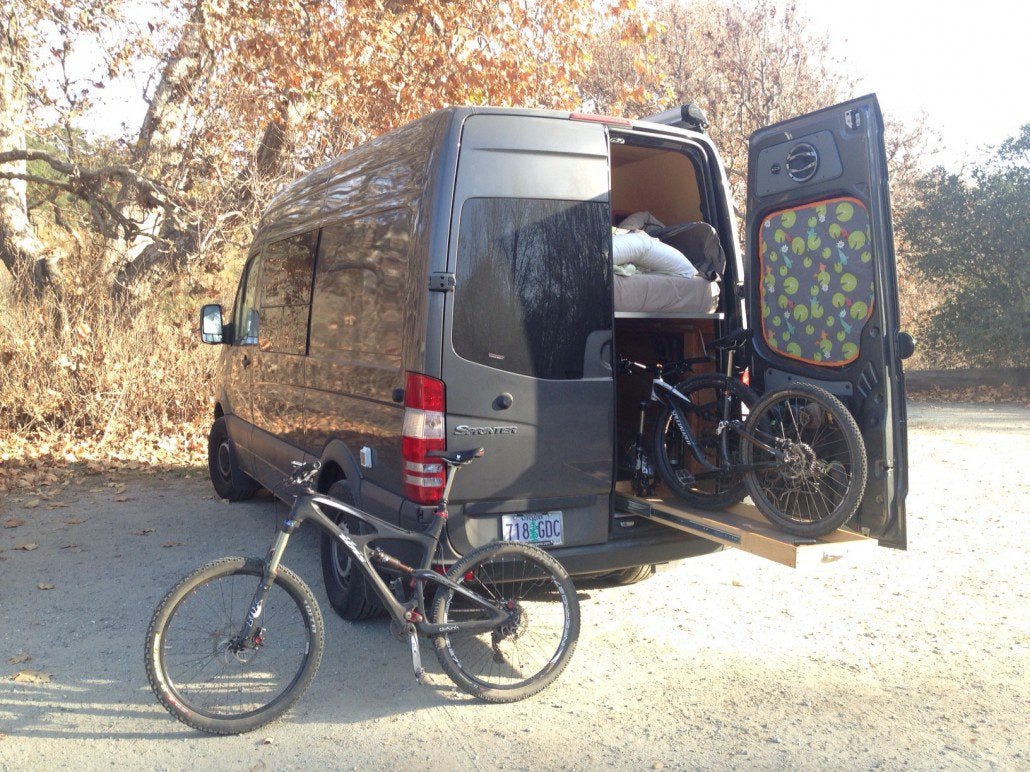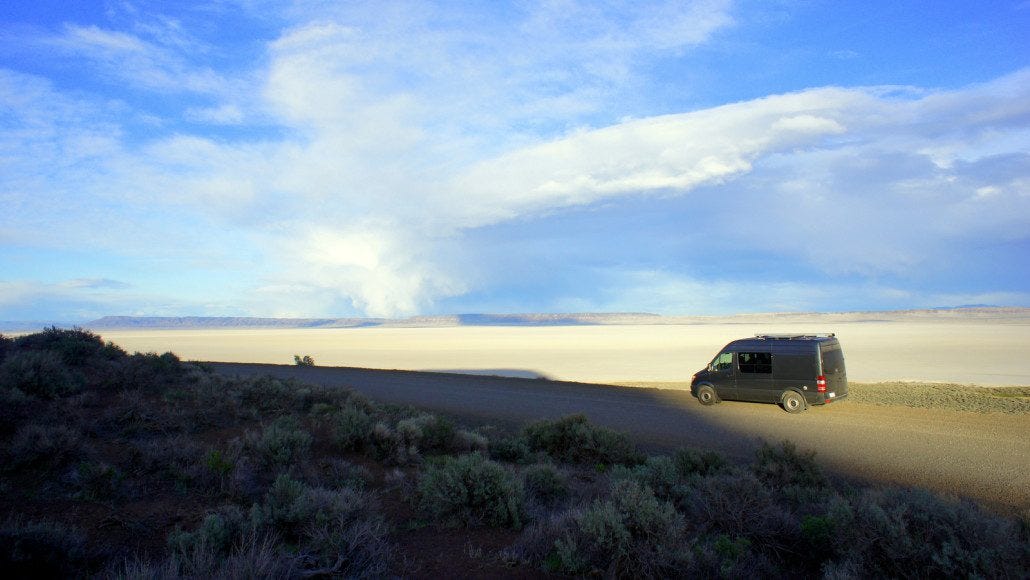The Adventure Mobile - Our DIY Sprinter Camper Van Bicycle Hauler
All the details of our Sprinter van buildout.
This post covers the DIY buildout I did for our Mercedes Sprinter to turn it into a bike-hauling adventure mobile. The goal was simple: create a functional, comfortable travel rig...without spending half my life creating it. (I'd rather mountain bike.)
Our build took about three months of occasional effort, plus one big three-week push. The result is a physical manifestation of fun and freedom that fired us up for an amazing three-year trip, with many more months since. (Careful, van travel is addicting.)
The Sprinter van is what we use to carry two mountain bikes and two touring bikes, plus climbing and backpacking gear, on a variety of adventures. Hopefully it motivates you to get your own van or helps buildout ideas. Buen suerte!
Just Getting Started?
Thanks to remote work and COVID, van life is hot the hottest thing ever and the amount of online information regarding DIY van buildouts is crazy. When we started, I spent hours searching sites and forums or trolling Pinterest.
To help sift through build options and save time, I recommend picking up this Sprinter conversion ebook. It's a comprehensive guide to DIY Sprinter vans and saved me a ton of time. The ideas and suggestions combine insights and featured buildouts.
Shortcuts to All Van Posts
For shortcuts to any van posts I've written, here you go! For details of our build, read on below this list. This post is a brain dump of many basics for our DIY van.
Favorite van upgrades I did after a year road tripping.
Van features I'd keep (and change!) if I built out a new van.
It was about time to upgrade our van batteries to lithium.
A quick video tour of the gear garage.
How to install solar panels or an Espar heater in your van.
My custom-made doorstop, a favorite improvement.
Downshifting from van life - #vanlife as a mindset, not a permanent travel mode!
Overview Photos
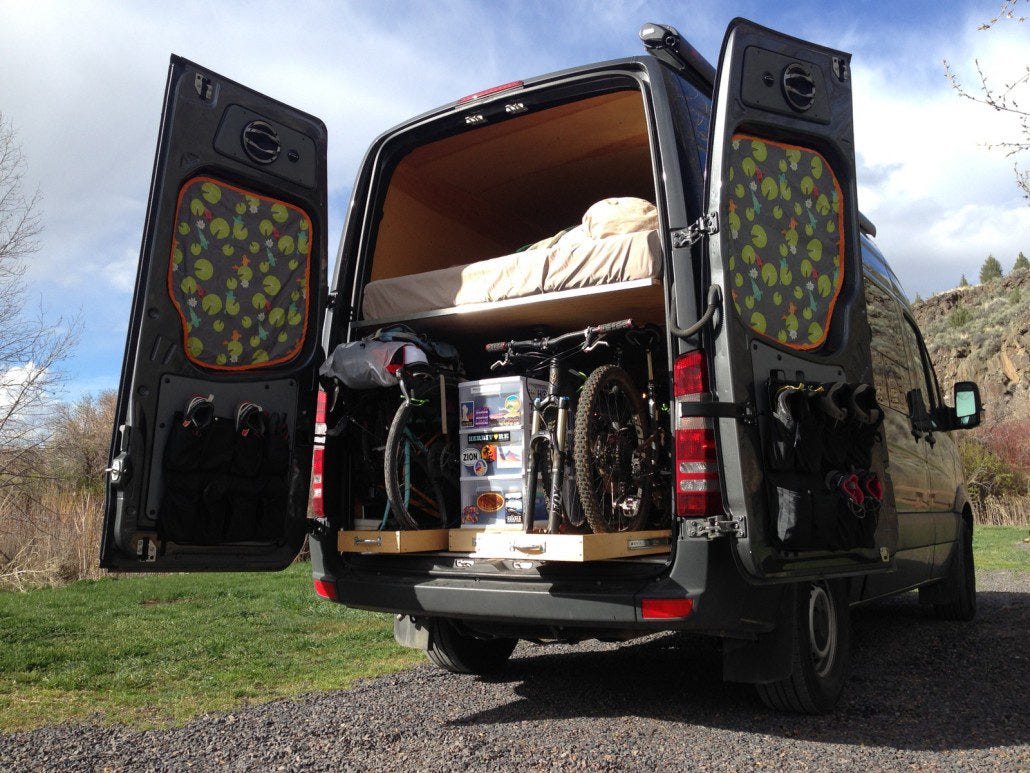
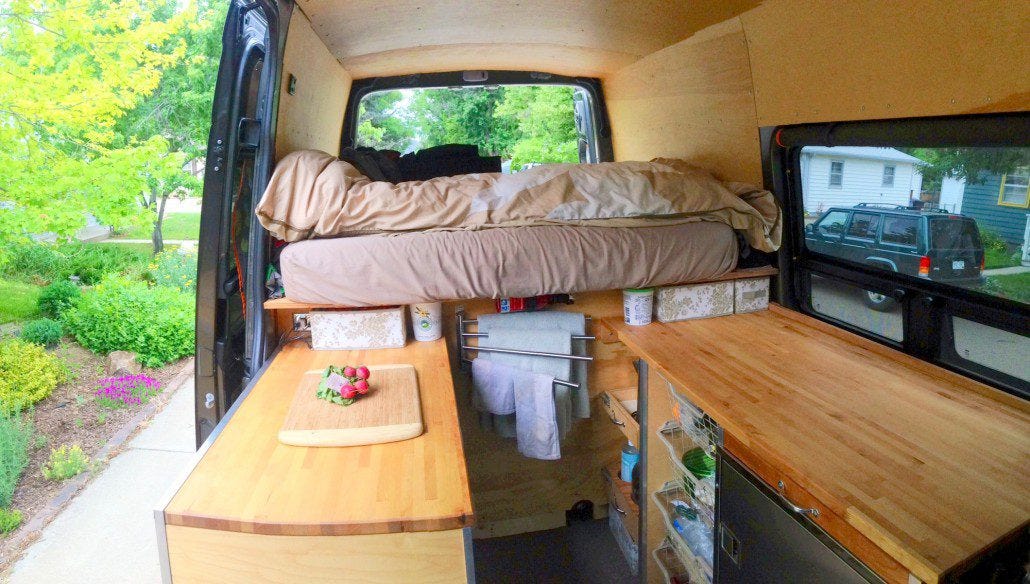
Buildout Details for Our Sprinter
I've got a few building skills acquired from working on houses with my dad growing up. That got me about 50% of what I needed to know to do this. The rest happened through over-confidence thanks to my (completely unrelated) engineering degree and extreme optimism, plus a dose of insanity.
Below are our main design criteria (and a lot of detail), plus links and info to help find specific parts and components. For our build, I ordered a huge amount of stuff from Amazon and many van supply companies continue to warehouse products there. Nothing like overnight shipping for free, right?!
By the way, dig these kinds of posts? Sign up for my free, 2x/month Traipsing About newsletter to level up your life around travel, creativity, and yup, van upgrades. After all, why bother building one out if it sits at home?!
Van size and model
We went with the 144" high-roof model. The length allows us to park in almost any parking spot and navigate cities like San Francisco mid-week as well as remote fire "roads" without getting stuck.
The high-top is a must have because it allows a 6'2" standing height inside. Sure, you can do a pop-top Vanagon/Sportsmobile style, but if you pop the top in a city then you're going to be super obvious, and those things can get drafty. Oh, and if you don't like working on cars or getting to know VW mechanics, Vanagons may not be your cup of tea.
The 4x4 model wasn't out when we bought our van, but we would still stick with the 2wd model now. We drive lots of fire roads and solid tires like the all-terrain BFG T/A KO2s (245 series) take us everywhere I want to go. If people can drive through South America 2wd, we'll be fine. Just my opinion, and of course the 4x4 looks badass!
Note: bigger is not always better. A few Sprinter-owning friends with the 170" van mentioned they wish they had the shorter version. Ask yourself what your hobbies are, whether you need more space for kids, and what kind of gear you'll be hauling.
Bed Design
This needed to be super comfortable so we could travel and not be desperate for a real mattress! If you're traveling long-term in your van, screw sleeping on Thermarests and buy a bed better than your dorm room bunk. We sleep with our heads pointing toward the front on a queen-size latex mattress that I hacked a foot off of with a machete.
Note: No need for posts to support the bed! Just use plywood or wood slats attached at the walls and reinforce those with 6061 C-Channel structural aluminum from somewhere like MetalsDepot.com. To answer an FAQ, the base of our bed platform is mounted 39" above the stock floor of the van. With dropper posts, I'd go with 36" next time.
Bike racks inside the van
Hauling four bikes (two touring, two mountain) and protecting them from theft, weather and road grime was important for our initial travels. The heavy duty sliders are the 48" heavy duty version, which are rated far stronger than we need (400 lb) but otherwise you can't get a 4' slider (and if you use that drawer for gear, you don't want a wimpy 200 lb rating anyway!). Yeah, they're expensive...and I wouldn't have it any other way!
If you only need ~3' pull-outs, the 200 lb version has worked well for our center drawer. I used 3/4" maple plywood to build them and lined the bottom with a clear plastic floor mat to protect the wood, with fork mounts from Universal Cycles. They work great.
Note: I've had a few questions about the tray size. The road bike trays are 60"x 13" x 3" (outside dimensions) and the mountain bike trays are 60" x 17" x 3".
Ventilation fan
Keep the van cool and aired out with a roof fan. Ours is right behind the front seats and keeps things nice and cool with the side windows cracked.
Why didn't we do A/C? Because we are scared of RV parks and A/C pulls WAY too much electricity...and I refuse to have a generator in my van. Let the 40' RV's do that lameness. We own camper vans, not portable homes! If we can survive a night in Death Valley where it was 100 degrees after sunset, we'll be fine anywhere.
(Model: Fantastic Vent 6600R rain sensing version. The variable-speed fan in the 6600 is a great feature.)
Battery and electrical system with a 2000W inverter
We charge laptops and phones, plus run a fridge. For A/C needs, we have a Ninja blender and a hot water boiler. If you don't have a dedicated 12V USB charging, these outlets are rad. They charge two USB devices and have two A/C grounded plugs as well.
Note: I highly recommend splitting the van alternator and battery circuit like this so that they are charged while you drive. (Update 2021: lithium batteries need a DC-DC charger like this.) This keeps things topped off even if it's cloudy or rainy. We also have shore power, which we rarely use.
Update February 2021: I recently swapped out our old-and-toasted AGM batteries for two mega-powerful Ohmmu batteries. These babies pack 300 amp-hours into the same space, weigh half as much, and have a lower life-cycle cost than AGMs. Ohmmu makes Tesla batteries and cranks out about 1.5x the capacity of Battleborn or other mainstream batteries (for the same price!). Here's the full writeup of my DIY upgrade.
(Models: Inverter - Xantrex PROWatt SW2000 plus the remote switch. Old batteries - Full River DC224-6 with 224Ah. New batteries - Ohmmu Group 31 with 300Ah)
Solar panels
Here's the full write-up I did on our install, a 12v DC system fed by two 100W panels. Since I installed ours, prices on kits dropped dramatically and now I wouldn't go with AM Solar. Renogy is SO cost-effective; here's their 200W setup, enough for most vans.
(Model: Grape Solar 2 x 100w with full system - GS 100 - from AM Solar in Oregon.)
Diesel Heater
Espar D2 diesel-fueled heater that runs off the main vehicle tank (see full description of installation to save some headaches). No propane tanks or extra fuel to carry around, and fewer things to break.
Update November 2020: After eight years of using ours, we've had zero issues with it. If you camp consistently at 8,000+ feet, get the high altitude kit. It's built into many units these days.
(Model: Espar D2 Airtronic via a screaming deal on Ebay.)
Passenger slider intermediate door stop
This is an addition we did in San Diego to stop the door from sliding all the way open every time we opened the passenger sliding door. If you didn't order it as a stock add, there's an expensive kit that Mercedes offers (PFFFFFT). We absolutely love this and I bet you will too. Rather than a long description, read more here if you're interested in the solution I came up with my brother-in-law. He has sold dozens of these to satisfied customers and people are even writing testimonials about them.
Swivel seats for the driver and passenger
180-degree rotation to convert the cab into seating and my desk. Note that this raises the seat height a couple inches.
(Model: Purchased from Sprinter Store in Tualatin, Oregon)
Cooking
Originally, we went with a portable propane stove that practically everyone I know owns. With updated batteries (LITHIIIIUM, BABY), now we have a mini-microwave and an Instantpot to handle cooking.
Fridge
As big as possible so we can bring plenty of grub for extended stays away from civilization. 12V DC, and far more efficient than a typical dorm fridge. It pulls about 2.5 amps running at full blast (though they spec 5 amps for startup amp pull), which means we have four days of battery life if it ran all the time. Adding an efficiency increaser I added as an upgrade cut energy usage by 50%
Gotta say, this is one of our favorite things in the van, and I can't even remember the days of coolers and ice. Popsicles after a bike ride in the desert=living large! Do yourself a favor and get a fridge... I will say that the workmanship on the Isotherm CR-130 fridge isn't amazing and we've had similar issues to what this writeup says.
(Model: 4.6 CF stainless steel Isotherm CR-130 purchased from West Marine.)
Water system
After 2.5 years of just water in jugs, I installed a Dometic sink, a cheap 12v electric pump (basically any will do), and 25 gallon water tank in the van. Check out the first item in this van upgrades post for some pics and links to what we used if you're interested. Glass jugs of water (to avoid chemicals leaching into our water) are still our go-to for drinking water.
Cabinets
Friends have sacrificed their relationships and well-being to create complicated cabinets. It's not necessary!
Ours are maple and birch plywood attached to the floor with L-brackets with $10 wire baskets from Ikea that are tough and light for the majority of drawers to keep weight down. There are also a few slide out drawers to hold appliances (hot water boiler and blender) and the four water jugs. This has worked great. Birch countertops to top things off - thanks again Ikea!
Side windows
Mercedes doesn't provide stock side-panel windows that open. We went with a window that many Sprinter converters use, the CR Lawrence tilt-outs, and they've been great.
With the aforementioned vent fan, it's fantastic to be able to open the windows (which are screened) and have airflow through the van without 1,237 blood-sucking mosquitoes joining in.
Note: I had these professionally installed by Van Specialties near Portland because cutting a couple giant holes in my brand-new van made me want to puke.
Interior
Sound deadening to mitigate road noise, plus insulation (open-faced denim insulation for walls and denim water-heater blanket from Amazon for ceiling), plus a thin, light-colored wood veneer so we feel like we're on a boat. (There is also the ready-made RB Components interior or a less expensive one from Van Specialties.)
In the buildout pictures gallery, you can see some details of my interior build. I used silver pan-head, self-tapping screws that were ~1.25" long. For the wall panels, I just screwed directly into the metal frame of the van. For the ceiling, I ran five strips of plywood first (see pictures gallery) to make mounting/finagling the ceiling panels into place easier.
Note: I played around with Rivnuts and decided they were HUGE overkill for attaching 1/8" plywood. Save yourself 57 hours and skip them. I did use Rivnuts to mount the bed to the wall.
Awning
Double our living space off the side of the van. Easy to crank out to the side, no whistling from wind while driving or noticeable reduction in mileage, and installation was *cough* a breeze solo on a tippy ladder. (Recruit a friend!) The awning isn't good in strong wind, but keeps the rain off and certainly the sun when wind gusts stay under about 20 mph. Given how little we use it, I might not buy one again.
(Model: Fiamma F65s, perfect for the 144" Sprinter. Purchased from the Sprinter Store.)

Curtains
Occasionally (ok, frequently), we pull into cities along the way and sleep in a quiet neighborhood. Yeah, we could get a hotel, but I paid enough for the damn van and I want the cost-per-use to keep dropping. Blackout curtains make this possible.
Ours are a two-layer black canvas facing out and a colorful design with snaps and magnets that keep it quick, clean and easy. These were the first time I'd ever used a sewing machine and turned out quite well. For the front windshield and passenger/driver windows, we went with a cab insulator kit, also from the Sprinter Store. Using these, we've stealth camped at least 100 nights in cities and never had anyone bother us.
Lights
12V LED lights that we installed two months into the trip in Santa Cruz. A MUST have, in retrospect. We have one diffuse (wide-spread) light a foot back from the headliner and another two spotlights over the countertops. Having fairy lights or mood lighting is a great addition as well.
Get the lowest temperature (warmer light) model that you can. Around 3,000 Kelvin seems to be what people like the most.
Note: I retrofitted our lights with photo filter paper from B&H and now we have a warm orange glow. I also installed a 12v LED light bar in the gear garage - both written about in this upgrade post.
Stereo system
Last but certainly not least, the High School Dream System that I couldn't afford when I was 18. I suspect we bump Macklemore more than most teenagers in Seattle.
For those putting in a subwoofer, ours is in a custom-built box in the space under the passenger seat down-firing toward the floor. Works great!
Note: with the most-excellent Alpine deck we installed, I can connect via Bluetooth from my laptop and watch movies with some serious bass and surround sound action. It's fantastic!
(Models: Alpine Bluetooth deck, 4 Hertz 6.5" mid/high speakers, ID 10" subwoofer, Helix 5 channel amp.)
Things I Learned Doing Our Buildout
Turns out building out a Sprinter is like building a house. Same decisions on finishes, same design dilemmas. Which isn't my favorite thing, by a long shot.
The saving grace? That this "house" had an engine and could give us access to nature and new places. That said, there were absolutely moments that I wanted to (and did) scream in frustration on a sunny Saturday when I was insulating it instead of shredding perfect mountain biking trails. Patience - the shredding happened later, and lots of it.
Drilling holes in a new Mercedes gets progressively easier as you make more of them.
Nothing in the entire vehicle is straight. Curved walls, floors, windows.
A full shop would have made this far easier. Almost everything was done on two sawhorses in our backyard with a circular or jig saw and an abacus for calculations.
DIY=prototype. Sometimes a permanent one, but in my mind, it was always "Wow, learned a good lesson there! I'll take advantage of that newly-earned skill next time I (insert incredibly frustrating, tweaky building activity)."
I could have been a contortionist given the small, awkward spaces I was able to cram myself into while building the interior.
Put the heater in the van BEFORE you go to Idaho in the winter to shiver in 20 degree weather and slither around on the frozen ground underneath the van routing fuel and electrical lines.
The process of building an adventure rig is immensely satisfying. I look at the completed Sprinter these days like a proud parent at graduation and am stoked (and surprised) that it turned out so well. Also, perhaps not like a parent (you tell me!), I pretend I don't see the little things I'd like to improve. In my day job there ain't much in the way of a finished, physical product, and so it was really rewarding to see something concrete come together.
Enough words. Time to start building your van!
If you read this entire post, plus comments, and can't figure something out, drop me a line. Maybe I can save you 12 hours of pain or at least throw a snide comment your way about how suffering builds character.
Happy van building!
Whoa, you read this entire post?! If you survived (or even enjoyed?) all the bad jokes, you'll probably enjoy my free 2x/month Traipsing About newsletter.




